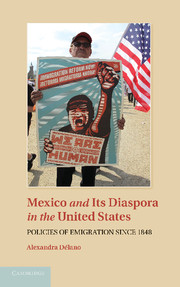Book contents
- Frontmatter
- Contents
- Acknowledgments
- Map
- Introduction
- 1 The Mexican State's Interests
- HISTORICAL BACKGROUND
- FROM LIMITED ENGAGEMENT TO ACTIVE EMIGRATION POLICIES (1982–2006)
- 4 From a Policy of Having No Policy to a Nation beyond Mexico's Borders (1982–2000)
- 5 The Migration Agreement (2000–2003)
- 6 Institutionalizing State–Diaspora Relations (2003–2006)
- Conclusions
- Bibliography
- Index
4 - From a Policy of Having No Policy to a Nation beyond Mexico's Borders (1982–2000)
Published online by Cambridge University Press: 05 July 2011
- Frontmatter
- Contents
- Acknowledgments
- Map
- Introduction
- 1 The Mexican State's Interests
- HISTORICAL BACKGROUND
- FROM LIMITED ENGAGEMENT TO ACTIVE EMIGRATION POLICIES (1982–2006)
- 4 From a Policy of Having No Policy to a Nation beyond Mexico's Borders (1982–2000)
- 5 The Migration Agreement (2000–2003)
- 6 Institutionalizing State–Diaspora Relations (2003–2006)
- Conclusions
- Bibliography
- Index
Summary
The 1982 economic crisis was the critical point of the structural and political problems in the Mexican growth model that had become apparent from the late 1960s and through the various crises in the 1970s. After Mexico announced a devaluation and the suspension of its debt payments, it began a process of profound reform of its economic model that implied direct and indirect support of the U.S. government as a crucial element to avoid a deepening crisis and the default of Mexico's international obligations (Meyer, 2003a: 12). Given the U.S. government's fear of a possible collapse of Mexico's political and economic systems, particularly in the context of instability in Central America during the Cold War, President Reagan gave a high priority to stabilizing the Mexican economy by providing lines of credit and other types of assistance (Kaufman Purcell, 1997).
The changes involved in the restructuring of Mexico's economy included opening the economy to foreign investment and imports, fiscal discipline, deregulation of key sectors of the economy, and privatization. This new model implied rejecting the statist policies of the past and a move toward accepting the liberal trading principles sponsored by the GATT and other international organizations. President Miguel de la Madrid (1982–1988) and the new political elite that he brought into his cabinet sought to abandon the nationalist discourse and protectionist models from previous decades and foster a closer economic relation with the United States.
- Type
- Chapter
- Information
- Mexico and its Diaspora in the United StatesPolicies of Emigration since 1848, pp. 123 - 164Publisher: Cambridge University PressPrint publication year: 2011



